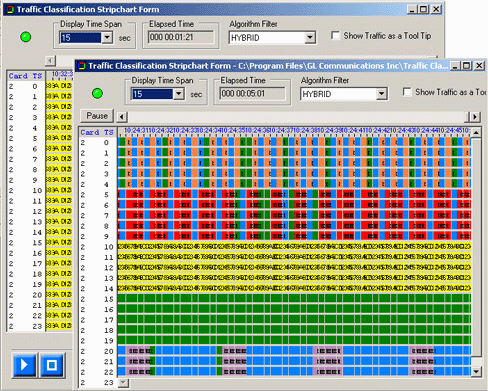Newsletter: GL Announces the Release of
T1/E1 Traffic Classifier
Welcome to the August issue of GL Communications' Newsletter providing information and insight into our latest product T1/E1 Traffic Classifier - A Tool for Non-intrusive, Real-time Monitoring and Classification of T1 and E1 Traffic.
Overview of Traffic Classifier
Do you know,what is happening on your T1/E1 network? How optimally are you (or your customer) using your T1/E1 network? You may be running a gigabit LAN for your internal network. But most corporate networks are still connected to the WAN through a T1 or slower connection. This speed mismatch between the internal network and the outside world may lead to a potential data bottleneck, and is an important reason why for any Network Provider or Network Manager to understand and analyze 'what is happening on their T1/E1 line".
GL's newest product, Traffic Classifier can analyze and classify various traffic such as voice, fax, data, tones (dial tone, ring-back tone, busy tone etc) as well as identify dialing digits and other events happening on a T1/E1 network. It uses various identifying schemes depending on the country of choice and classifies the traffic, based on the dialing tones stipulated for that country.

Benefits of using GL's Traffic Classifier
Knowing how customers use your network is essential for proper planning and engineering of a network. GL's Traffic Classifier will enable you to:
- Plan for the Future
Up-to-date information on the traffic trends is essential to accurately plan for growth. Only GL's Traffic Classifier provides this essential information. - Build a Business Case
What is the business case for changing your network capacity? How do you deal with digital data? The Traffic Classifier can tell you all these. - Outflank the Competition
The Traffic Classifier lets you anticipate customer needs. A satisfied customer is your best customer. - Optimize your resources
Ensure that you maximize your current resources. The Traffic Classifier lets you compare loads on a channel-to-channel or T1/E1-to-T1/E1 basis.
GL's Traffic Classifier Applications
- Real-time Snapshot
Get a real-time snapshot of your T1/E1 network activity. - Surveillance and Data Collection
You can monitor all the events on all the timeslots on a single or multiple T1/E1 line. You can also do surveillance for extended periods by recording the classification results for days, weeks or months at a time. - Equipment Manufactures and Equipment Vendors
Use GL's Traffic Classifier to do pre-deployment analysis of a network so as to provide an optimized solution for your customers. - Research and Development, Traffic Engineering and Network Condition Analysis
GL's Traffic Classifier is an ideal tool in an R & D environment for understanding, analyzing and traffic engineering of a T1/E1 network.
Main Features of GL's Traffic Classifier
- Ability to non-intrusively monitor T1 or E1 line in real-time and offline modes.
- Sixteen traffic types are classified, which include Tones (dial, ring, busy), Voice/Speech, Data and Fax Signaling, Dialing digits (DTMF, MFR1, MFR2F, MFR2B) etc.
- Data and fax modulations such as V.22, V.34, V.29, V.32, and V.27 are supported as traffic types.
- Monitor single or multiple DS0s on multiple T1/E1 lines.
- Monitor the T1/E1 line locally or remotely through TCP/IP connection.
- Provides real-time display of the traffic types for each DS0 on the T1 / E1 trunk.
- Result options allow the results to be either displayed on the screen, and/or save it to a file for extended periods.
- Off-line (playback) feature can playback or fast forward previously recorded results.
- Analyzes the T1/E1 traffic and graphically displays the results as a strip-chart.
- Codecs supported - mu-law, A-law, and linear.
- Traffic view for a particular span of time by using the File Scroller option.
- Four algorithm options (Linear, quadratic, hybrid and hybrid filtered) to fine-tune the classification results.
Types of Traffic Classified
- Unknown (Silence) - Channel handling a call but no signal is detected (eg: pause in speech)
- V22FOR (V.22 Forward) - Slow modem (forward channels) - typically Point of Sale terminals like VISA- 2400 bps
- V22REV (V.22 Reverse) - Slow modem (reverse channels)- 2400 bps
- V34V90UP (V.34) - Fast modem- 33600 bps
- V29- Common fax- All speeds
- V32V17GT24 (V.32) - Fast fax and modem- >2400 bps
- V27AT48 (V.27) - Slow fax- 4800 bps
- V27AT24 (V.27) - Slowest fax - when V.29 has transmission problems, this mode is used as fall back.- 2400 bps
- Voice- Speech
- BINV90DOWN (Binary) - Native binary - ISDN Basic Rate Interface- 64000 bps
- FSK- Fax signaling - page break, end of page, end of transmission- 300 bps
- Digits- DTMF/MFR1/MFR2F/MFR2B Digits- 40 bps
- Dial Tone
- Ring-back Tone
- Busy Tone
- Idle- channel is on-line but not in use (digital silence)
For more information about GL's Traffic Classifier product please click here
 Back to Latest News Page
Back to Latest News Page